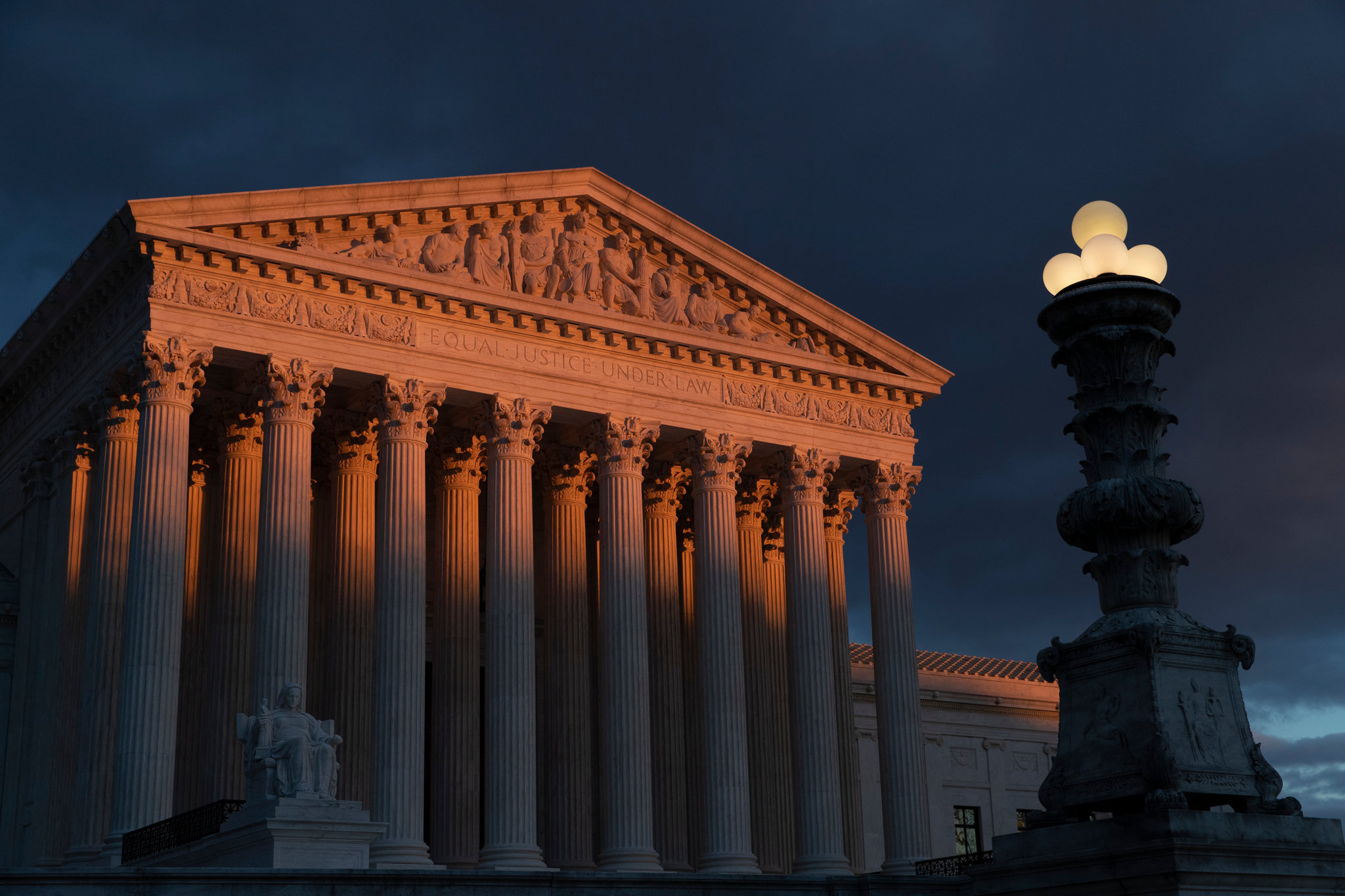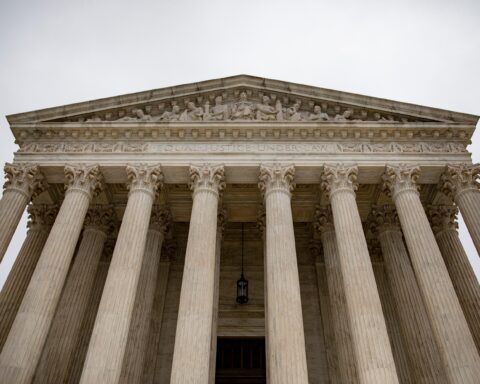The Supreme Court will hear oral arguments Wednesday in a case that could broaden gun rights nationwide and transform how the Second Amendment is interpreted in the United States.
On the surface, the dispute involves whether a New York law that restricts individuals from carrying concealed handguns outside the home for self-defense passes legal muster. The case is brought by two individuals and the New York State Rifle and Pistol Association, which is affiliated with the National Rifle Association.
The court’s six conservative justices could look skeptically at the broad reach of the law and could ultimately make it easier for individuals to carry arms for self-defense outside of the home.
But at oral arguments, all eyes will be on the court’s two newest members, Brett Kavanaugh and Amy Coney Barrett, to see how far they push their colleagues to do something more.
As lower court judges, the two Donald Trump nominees signaled that they think courts need to rethink the framework often used to measure how every other gun regulation should be evaluated. If Kavanaugh and Barrett’s view of the issue prevails, critics fear the conservative wing of the court will not stop at allowing more people to carry guns in public for self-defense. Instead, the court could junk the legal test that has been used to uphold most gun restrictions in the lower courts over the past decade and provide what critics fear will be a road map for lower courts to look skeptically at a whole range of other gun laws.
Kavanaugh and Barrett, in their previous roles, rejected an approach grounded in balancing an individual’s right to bear arms against the government’s interest in passing the law at issue. Instead, they said judges should focus on the text, history and tradition — the intent of the founders — in weighing a gun restriction.
“History is consistent with common sense,” Barrett wrote in a 2019 dissent in a case concerning a felon disarmament law.
As for Kavanaugh, in a 2011 dissent concerning a ban on semi-automatic weapons, he said he reads Supreme Court precedent to mean that judges should not “recalibrate the scope of the Second Amendment right” based on a “judicial assessment” of whether the law advances an important government interest. Instead, they should look to history.
He acknowledged that the approach might cause complications when courts are looking at some new gun regulations that relate to a condition that did not exist in the founding. But, he stressed, “the Constitution is an enduring document, and its principles were designed to, and do apply to modern conditions.”
Such an approach that wholly rejects any consideration of the government’s interest in the law worries supporters of gun restrictions.
“Given the significant increase in gun violence around the country, the last thing we need is a decision that would allow lower courts to start striking down strong gun laws simply because they can’t find what they think is sufficient support for them hundreds of years ago,” said Eric Tirschwell, executive director of Everytown Law.
Supporters of New York’s law say that changing the lens through which courts examine gun laws could ultimately lead to courts striking down more restrictions in a variety of areas related to guns.
Since the Supreme Court issued a landmark opinion in 2008 holding for the first time that the Second Amendment protects an individual’s right to keep and bear arms, and a follow-on decision two years later, lower courts have often analyzed gun laws using a two-part test. First, they look to see if the restricted activity is protected by the Second Amendment, and then they apply the appropriate level of scrutiny to analyze the law.
If, for example, a restriction goes to the core of the right, it triggers what is called “strict scrutiny.” Such a law faces an uphill climb. It must be “narrowly tailored” and it must serve a “compelling government interest.”
A less exacting standard would be “intermediate scrutiny.” A law analyzed under that tier has more of a chance to survive because the government has to prove only that it is “substantially related to an important government interest.”
Since the Supreme Court has not decided a major Second Amendment case in more than a decade, it has not had the chance to weigh in extensively on the legal tests lower courts should be applying. Because of that, a “tiers of scrutiny” approach has been utilized and most restrictions since 2008 have been upheld.
That could change soon.
“In some ways the methodological question of how the justices need to analyze these Second Amendment rights are equally important, and maybe even more important in terms of the spillover effects of this case for future cases,” said Roman Martinez, a Latham & Watkins lawyer who frequently argues before the court.
“The test that the justices develop to assess the New York statute at issue here will then be used by lower courts to assess the constitutionality of gun restrictions imposed by other states and the federal government,” he said and added, “So the stakes are high.”
When Kavanaugh speaks up at oral arguments, he could press his views on using text, history and tradition to determine whether a restriction should fall.
The thinking goes that if there hasn’t been a history or tradition of imposing a certain type of regulation, then that regulation is basically invalid.
In 2011, Kavanaugh made clear how he thought the law should be analyzed.
Supreme Court precedent “leaves little doubt that courts are to assess gun bans and regulations based on text, history and tradition, not by a balancing test such as strict or intermediate scrutiny,” Kavanaugh wrote in his dissent. He said such a test might actually protect the ability for states and the federal government to impose more restrictions on gun rights.
“Indeed, governments appear to have more flexibility and power to impose gun regulations under a test based on text, history, and tradition than they would under strict scrutiny,” he said.
Interestingly, one “friend of the court” brief filed to the Supreme Court by a judicial conservative in the New York case argued that the law should be upheld and analyzed under an approach that looks to history.
The brief was filed on behalf of J. Michael Luttig, a conservative who used to serve on the 4th US Circuit Court of Appeals. He argues that the New York law at issue can be upheld if evaluated under text, history and tradition. He said that “a constitutional right to bear arms outside the home, in public and in public places, has never been unrestricted, and indeed, has historically been restricted in many public places.”
That view does not give comfort to supporters of gun regulations.
“There is no good reason why gun laws in 21st century America should be tied to or limited by how 18 and 19th century America responded to the threat of muskets in a very different nation,” said Jonathan Lowy, chief counsel of the Brady Campaign.
Lowy believes that courts can look to text, history and tradition but they must also consider a government’s interest, especially in the context of new weapons in the modern day that address new conditions.
Writing for a group of law professors, Donald Verrilli, former solicitor general for the Obama administration, warned that “text, history and tradition” don’t always speak with one voice “and that a test of whether a law passes constitutional muster thus cannot always depend on how long a law has been on the books.”
In his brief he highlighted that a text and history approach could endanger limits on places like airports and planes.
“It is clear, for example, that airplanes are the kind of ‘sensitive places’ where legislatures should be able to prohibit weapons,” Verrilli argued in briefs in support of New York. “However, Congress did not regulate firearms in airplanes until the 1960’s, many years after airlines began commercial service. Thus, it is hard to see how a court applying a purely historical test could uphold restriction on weapons in flight.”
As for Barrett, when she submitted her Senate questionnaire as part of her confirmation process, she listed the 2019 case as one of the most significant that she had decided.
She noted that a man named Rickey Kanter was challenging the application of a federal and state felon dispossession law that prevented him — as a nonviolent offender — from owning a firearm. He argued that the laws violated his Second Amendment rights. A panel of the 7th US Circuit Court of Appeals upheld the application of the law.
“I dissented,” she wrote in the questionnaire.
“Looking to the Founding-era history, I explained that legislatures have the power to prohibit dangerous people from possessing guns, but that power extends only to people who are dangerous, not to nonviolent offenders like Mr. Kanter,” she said.





